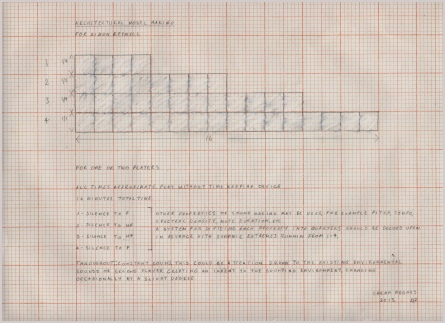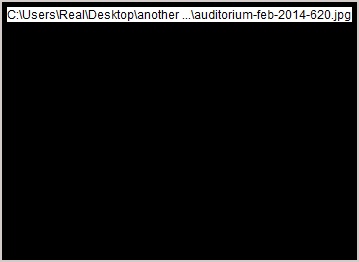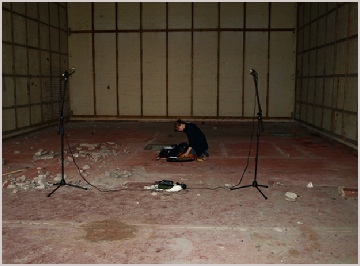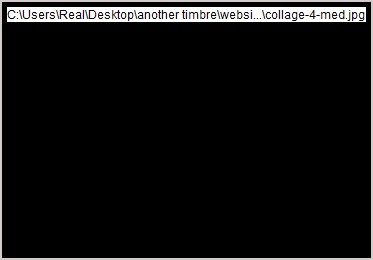Another Timbre TimHarrisonbre

Sarah Hughes graphic score project
‘Architectural Model Making’
Sarah Hughes is one of the most compelling and original voices to emerge in contemporary music in the past 10 years. She is a founding member of the Set Ensemble, and (with Patrick Farmer) co-edits the journal Wolf Notes and co-runs the website and label Compost and Height With David Stent she also runs the experimental music publishing site BORE Her own work stretches across sculpture, installations, improvisation, interpretations of other musicians’ work, and, more recently, composing scores - some textual, some graphic.
For this project we took one of Sarah’s graphic scores - entitled ‘Architectural Model Making’ - and sent copies to a range of musicians, asking them to produce realisations. You can see a copy of the score opposite on the right, and you can hear the nine realisations by clicking on their names from the list below.
Below there is also an interview with Sarah about this project and her work generally.
Contributing Musicians
Lali Barrière / Eduard Màrquez
Interview with Sarah Hughes
You trained as an artist rather than a musician. Can you describe how you have come to work in both visual and sound media?
As I recall it came out of spending a lot of time thinking about site and space, considering how materials are affected by their location, context, situation, etc. I tried to use sound as a material in installation work but there was really only one instance where I think I managed to do this successfully: an installation in the basement of the Victoria Swimming Baths in Manchester. The piece involved twenty electronic mosquito deterrents placed together in a room, producing a very high frequency on the edge of audibility. As the devices all had the same frequency the energy of the sound dissipated at the same rate, thereby creating an auditory space which the viewer / listener could step in and out of that was distinct from the parameters of architectural space.
My attempts to work with sound installation were pretty short-lived and I became more interested in the compositional aspects of improvisation, particularly the durational and spatial placements of sound.
So how do – or don’t - art and music connect in your current practice?
I find sound functions differently in installation than in composition and improvisation. The various difficulties I experienced early on lessened as I started to think that the physicality of a sound or silence isn’t very different from the physicality of an object, and the way that sounds and silences are composed isn't very different from how objects can be placed and arranged within space. Common to both is the placement of matter into space, and how these placements inform one another, react, create juxtapositions and dissonance, etc. I can see this across my installation, works on paper, composition and improvisation.
There is a tendency of the viewer/listener to comprehend the visual as an image (apprehended all at once), and the auditory as a durational event or an experience that one is surrounded by, yet art can be experienced as a duration just as music can be experienced as image. There is an interesting tension between these types of experience - between the instance and the context. The use of series and repetition becomes constructive here, as does the filtering of visual work through a variety of media, where the stasis of an image is disrupted.
I suppose that the Architectural Model Making project can be seen in terms of series and repetition, but we’ll come back to that. I first heard you in an improvisation context, but given your background, it somehow seems right that you have also come to composition. How long have you been composing pieces, and what kinds of scores have you produced to date?
Since 2010. The first few pieces were very simple text scores, or pretty unsuccessful graphic scores. I think these became more coherent as they came closer to the work I was doing with installation, drawing and collage. The Sketchbook Series, of which Accidents of Matter or of Space was the first, comes out of, as the name suggests, sketchbooks of mine that I revisited. These run parallel to and occasionally overlap with another series of scores that use Lucretius’ De Rerum Natura as a point of departure. Architectural Model Making is likely to be the first in a series of scores that are reworked from finished pieces, rather than sketchbooks, or possibly coincide with a series that develops new (art) works and scores concurrently.
The later scores tend to use divisional measurement, for example dividing time periods into halves, eighths etc. or present various permutations of notes or orders. The scores from the Lucretius series have quite a complicated interrelationship, relating to the structure of the six books that comprise the poem. They are mostly a mixture of text and notated pieces and all leave a lot of room for interpretation from the performer, and intentionally bridge the point of composition and improvisation.
You mention having produced some ‘pretty unsuccessful graphic scores’, which seems to me to be par for the course. Perhaps it’s difficult to generalise, but – thinking beyond just your own experiences – what would you say constitutes ‘success’ in a graphic score? And what would you say are common pitfalls in the area?
There has to be something that ties the graphic quality of the score to the sound that is more than an arbitrary similarity of form. I think things start to break down when a score is approached (by composer or performer) purely in terms of iconicity or a visual onomatopoeia, as it is likely that an engagement with the grammatical aspect of the score is subsequently lost.
The degree to which a performer engages with a score is always important, but I find graphic scores need a bit of extra work as there is more for the performer to do in terms of familiarising themselves with a language (not image) that isn’t transferable to another context, i.e. to another score. The success of a piece of work is a complex and contestable thing but if the internal logic, here described as the language, isn't negotiated, then the presence of the composer is arguably made redundant and the score slips into the realm of improvisation.
This is only one small aspect of what constitutes success – there is also the realisation, performance, recording, canon, etc. – but it is one upon which I think the rest are commonly predicated.
Yes, that’s well put. But what is it about graphic scores that attracts you as composer? Presumably there’s an interest in openness, in giving the interpreter a larger role in determining the music. But this could also be done either through text scores or in various ways involving conventional notation. So what is it that has drawn you to graphic scores?
I think quite visually and find certain things easier to articulate as an image. Even with a score such as (can never exceed unity), which has a text instruction for the division of time, I had to draw out a ‘realisation’ of what was in my head, and write out the instruction from there – just to be clear that what I’d written related to what I wanted to happen in space. This ended up forming part of the score. I find space easier to figure out on paper, rather than text or notation. I think of graphic scores in four-dimensions and when they are approached as images a lot is lost. For me, they are suggestive of space, duration and placement of material. It’s like constructing a performance space on paper.
So moving on to the Architectural Model-Making score itself, first of all I wondered if you have ever performed the piece, or planned a realisation yourself?
You know, that had never occurred to me.
That’s interesting. Another composer who I talked to when I conceived this project, who works with beautifully drawn scores that she interprets herself, decided in the end that she wasn’t ready to pass her scores on to other musicians; they felt too personal for her to allow interpretations by others. Your attitude is obviously very different.
Can I ask a couple of questions about the score that I think I’d be curious about if I were preparing a realisation? First, why did you use graph paper? And why the rough brushwork in the squares?
When you first approached me about the project you mentioned a piece of work on my website of pencil and emulsion on graph paper. When it came to writing the score I referred back to this piece, which is the plan of a patio, with measurements and a scale drawing. The paving slabs are painted in with an emulsion wash. I took the measurements for the paving slabs and, referring back to earlier scores, altered them slightly and translated them into duration, so that with a total time of sixteen minutes, the piece is divided at 8 minutes, 4 minutes and 2 minutes.
Working again from the original piece I took the white emulsion wash as a layer of sound – not as solid sound, nor a tone, it was translated as a sound that sat above or beneath the composition as an insinuation or background activity. For me, graph paper is an affective analogy for the activation of space that isn’t occupied by an event. The score is on imperial graph paper (as was the work on paper) but this is really a matter of what is to hand. However, metric paper has a tighter weave and the score would probably have come out differently if I'd have used it.
And what about the title – Architectural Model Making?
Thinking about how I wanted the score to be read it was clear it wasn’t as an image, nor strictly as a diagram; it was something more akin to a model or a maquette. A lot of my visual work uses architectural space as a medium, and this is equally relevant to music and composition. Pieces like Criggion (on the CD ‘Accidents of Matter or of Space’, Suppadaneum, 2013) are testament to how I see architectural space relating to the form and material of a piece. I see composition as constructing space and I wanted to get that across in the title.
Several of the musicians who were invited to produce realisations of the piece came back to you with questions about the score. What kind of things were they asking, and did it surprise or concern you that they were seeking further direction or clarification?
At first I was a little concerned that the score wasn’t clear, but the realisations I’ve heard are all very good and definitely portray the intention of the composition. The questions I received indicated that the musicians were engaging with the score and thinking about how to handle it. For example, a couple of musicians asked whether it was to be recorded as a performance or in sections that could be edited together. These kinds of things are very much dependent on the musician’s set-up so either approach is fine. There is a good balance between composer and performer in the realisations I have heard so far. At no point have I felt absent from the realisations, but the character of each performer is also present. In cases like Joonyong’s realisation, where he initially read the layers as different players and asked if the piece could be played by a quintet, the balance still works, despite the extended reading. I like these instances where there is an unexpected response; it enables the work to be seen from a slightly different perspective and provides thought for further compositions.
Yes, I think it’s fair to say that while there are different perspectives evident in each of the realisations I’ve heard, there is also something that seems common to all of them as well. This takes me back to what you said earlier about series and repetition in music, and how it can change the way we listen to a piece. Is this something that you feel operating here through these multiple realisations?
That’s interesting. I find the Architectural Model Making project creates one work, rather than one score and multiple realisations, and have to take account of that. I haven’t really thought of series and repetition relating to a realisation before, but the project grounds the realisation to something outside of myself, and I find that interesting. They are a series, and with that grounding the repetition becomes affective. It all sounds a bit analytical, but repetition doesn’t really come up if the only common element is the composer – I guess it needs a context, something to which it can relate. There was a similar scenario with (can never exceed unity), where three realisations of the same score were released on the same disc (Suppedaneum, 2013). The thing that held the three realisations together wasn’t just that I was the composer, but that they were performed by the same musicians, and recorded by the same person, all in one session. That kind of contour is important.
You’ve made clear that for you an important aspect of this piece (as with much of your work) is in perceiving and understanding sound ‘architecturally’ as something that takes place and shape in a particular space. Are you concerned that in a project like this the sounds become abstracted from the spaces where they were realised? Of course this is a danger with all recording, but does it worry you that listening to multiple realisations – especially on laptop speakers! - might flatten rather than highlight the architectural element of the score?
No, Architectural Model Making was written for this project, so I knew from the outset that the recording would be the primary site of reception. This is referred to in the title as the constructing of space, but one that is mediated. The recorded realisation creates another space which belongs to the listener, so rather than flattening the architectural element of the score it creates a multiplicity of different spaces. These spaces can be very different. I don't like to listen to music on headphones as it disorientates me - the space it creates is very different to that of a room with a couple of speakers set a few feet apart. Listening though monitors speaker is very different to listening through perfectly good stereo speakers etc. If one listens responsibly (i.e. not through laptop speakers) then the capacity of the recorded realisation is as great as a live realisation, though very different. It is the same with installation - how does one record a composed space with fidelity to the original? Is it even necessary to try? I find it more interesting to accept that they are two different types of event and the success of a recorded composition has a different set of criteria to that of a live realisation.
For more examples of Sarah Hughes’s work, go to her website here
Click here for a larger image of the score
TEXT FROM SCORE:
‘Architectural Model Making’
For one or two players
All times approximate; play without time-keeping device
16 minutes total time
1 – silence to f
2 – silence to mf
3 – silence to mp
4 – silence to p
Other properties of sound making may be used, for example pitch, tempo, spectral density, note duration etc.
A system for dividing each property into quarters should be decided upon in advance with dynamic extremes running from 1 to 4
Throughout: constant sound. This could be attention drawn to the existing environmental sounds or second player creating an indent to the sounding environment, changing occasionally by a slight degree.
Sarah Hughes
2013 2/2



Sarah Hughes in the Criggion power station

Work on graph paper by Sarah Hughes
‘Auditorium’ by Sarah Hughes, 2014